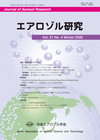All issues

Volume 17 (2002)
- Issue 4 Pages 246-
- Issue 3 Pages 164-
- Issue 2 Pages 82-
- Issue 1 Pages 4-
Volume 17, Issue 3
Autumn
Displaying 1-9 of 9 articles from this issue
- |<
- <
- 1
- >
- >|
Feature Articles -Trend of the International Standard for Aerosol Measurements and Cleanliness-
-
Kazuo ICHIJO2002 Volume 17 Issue 3 Pages 164
Published: September 20, 2002
Released on J-STAGE: October 10, 2008
JOURNAL FREE ACCESSDownload PDF (506K) -
Hideyuki TSUGANE2002 Volume 17 Issue 3 Pages 165-168
Published: September 20, 2002
Released on J-STAGE: October 10, 2008
JOURNAL FREE ACCESSDownload PDF (654K) -
Chikao KANAOKA2002 Volume 17 Issue 3 Pages 169-172
Published: September 20, 2002
Released on J-STAGE: October 10, 2008
JOURNAL FREE ACCESSDownload PDF (591K) -
Kensei EHARA2002 Volume 17 Issue 3 Pages 173-178
Published: September 20, 2002
Released on J-STAGE: October 10, 2008
JOURNAL FREE ACCESSDownload PDF (713K) -
Shuji FUJII, Naoki KAGI2002 Volume 17 Issue 3 Pages 179-184
Published: September 20, 2002
Released on J-STAGE: October 10, 2008
JOURNAL FREE ACCESSDownload PDF (624K) -
2002 Volume 17 Issue 3 Pages 184
Published: September 20, 2002
Released on J-STAGE: October 10, 2008
JOURNAL FREE ACCESSDownload PDF (477K)
Research paper
-
Takeo SAKANO, Yoshio OTANI, Norikazu NAMIKI, Hitoshi EMI2002 Volume 17 Issue 3 Pages 185-190
Published: September 20, 2002
Released on J-STAGE: October 10, 2008
JOURNAL FREE ACCESSIn the present work, a new model for predicting the pressure drop of dust loaded medium performance air filters is proposed by introducing the collection efficiency raising factor, λ , the pressure drop raising factor, β , and the pressure drop raising exponent, γ , and the applicability of the model is experimentally investigated. As a result, it is found that, i) the pressure drop raising exponent γ is about 1.3, the value of which is common for all the filtration conditions studied in the present work, ii) there exists a strong correlation between λ and β , and therefore it is possible to predict the time dependency of pressure drop from that of collection efficiency or vice versa.View full abstractDownload PDF (738K)
Technical paper
-
Hidenori YOSHIYAMA, Takao NISHIMURA, Atsushi NAKAMURA, Tomoyuki NONAKA2002 Volume 17 Issue 3 Pages 191-196
Published: September 20, 2002
Released on J-STAGE: October 10, 2008
JOURNAL FREE ACCESSAn automated instrument which made possible to analyze of an elemental sulfur in particulate matters in real time was presented. Sulfur component in the particles (mainly sulfates) was introduced to flame chimney and converted to sulfur monoxide by reduction in a hydrogen-helium mixed gas. Then, sulfur monoxide formed is further oxidized in the reaction cell by ozone supplied from an ozonizer. The resultant excited state sulfur dioxide emits light and the concentration of elemental sulfur can be determined by using a photoluminescence detector. The calibration curve during 1.6 to 95 ppb showed clear linearity and the detection limit was estimated around 1.2 ppb for this system. The performance and feasibility of this method to the aerosol measurement were evaluated with ammonium sulfate aerosols generated by a spray drying method, and the concentration of the aerosols was controlled by changing spray pressure from 98 to 294 kPa. Size distribution of the particles was measured by EAA, and the volume concentration was calculated from the data. The results points to the excellent agreement between the values by VSCD (Vacuum-type Sulfur Chemiluminescence Detector) and those by EAA. VSCD showed excellent performance and feasibility for the automated real-time measurement. In the last, the nitrogen-oxygen addition method was described for the measurement of sulfur in exhaust gas from diesel engine as the example of appication.View full abstractDownload PDF (634K) -
Isao TANAKA, Tomoaki KAJIMA, Yoshinobu SUZUKI, Takuya KUNITOMO2002 Volume 17 Issue 3 Pages 197-202
Published: September 20, 2002
Released on J-STAGE: October 10, 2008
JOURNAL FREE ACCESSIn this study, polyurethane resin sealant of non-solvent type for cleanroom was developed in order to reduce the release of gaseous organic contaminants from sealant. The emission rate of hydrocarbon gas from the newly developed sealant was 1/10 to 1/100 of the conventional sealants, which drastically reduced the adsorbed mass of organic compounds on silicon wafers. The estimation of adsorption energy of the newly developed sealant suggested that the vapor of plasticizer used in the sealant hardly adsorbed on silicon wafers.View full abstractDownload PDF (635K)
- |<
- <
- 1
- >
- >|